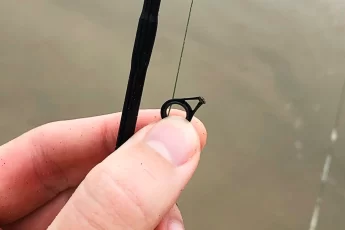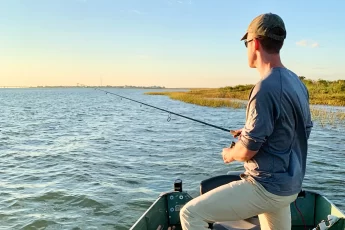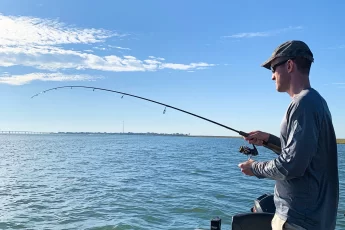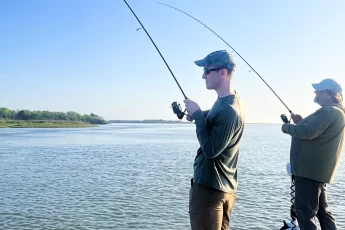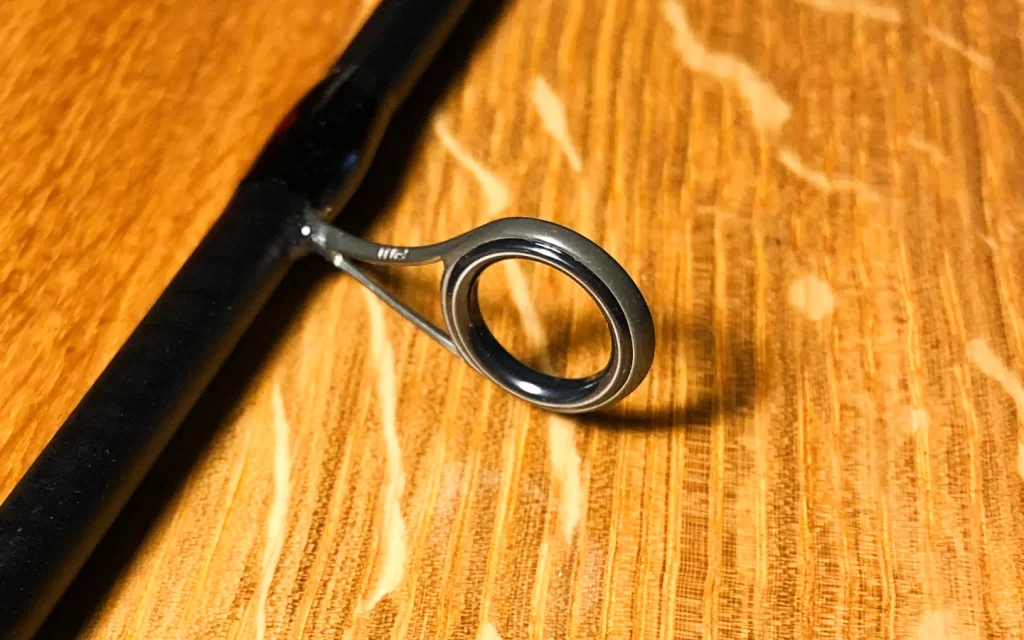
For those serious about their angling pursuits, it is important to understand fishing rod guides and their effect on the fishing experience. In this comprehensive guide, we dive into the intricacies of rod guides including their diverse types, materials, and the pivotal role they play in shaping how your fishing rod behaves.
By the end of this article, you will possess the knowledge needed to make informed choices when selecting the ideal fishing rod for your pursuits.
*Disclosure: I only recommend products I would use myself and all opinions expressed here are my own. This post may contain affiliate links that at no additional cost to you, I may earn a small commission.
Table of Contents
- What are Fishing Rod Guides?
- Rod Guide Key Functions
- Rod Guide Components
- Rod Guide Materials
- Types of Rod Guides
- Fishing Rod Guide Design Differences
- Single Foot vs Double Foot
- Roller Guides
- What to Consider When Picking Rod Guides?
- Cheap vs Expensive Guides
- How to Pick the Right Guides for You
- Rod Guide Care Tips
What are Fishing Rod Guides?
Fishing rod guides are small, cylindrical components that are attached to a fishing rod’s blank that serve a critical role in casting and reeling fishing line. Their primary function is to control and direct fishing as it moves from the reel through the tip of the rod.
Rod Guide Key Functions
Here’s a brief overview of key functions of fishing rod guides:
- Line Management: Guides are designed to prevent the fishing line from tangling or coming into contact with the rod blank, which could cause friction and reduce casting distance and accuracy.
- Line Control: Guides guide the line’s path, helping to distribute tension evenly across the rod’s length. This distribution is critical for maintaining the rod’s integrity and sensitivity.
- Casting Performance: The arrangement, size, and type of guides on a fishing rod significantly impact its casting performance. Properly spaced and sized guides reduce line friction during casting, allowing for smoother and longer accurate casts.
- Sensitivity: Guides can affect the rod’s sensitivity by influencing how vibrations and force from the line are transmitted through the rod blank to the angler’s hand. Properly chosen guides can enhance a rod’s sensitivity, making it easier to detect subtle strikes.
- Heat Dissipation: When using heavy lines or reels with strong drag settings, guides can help dissipate the heat generated by the friction of the line passing through them, preventing damage to the line and the rod.
Rod Guide Components
The primary components of fishing rod guides include the rod guide frame, an insert, the guide wrap, and the guide foot.
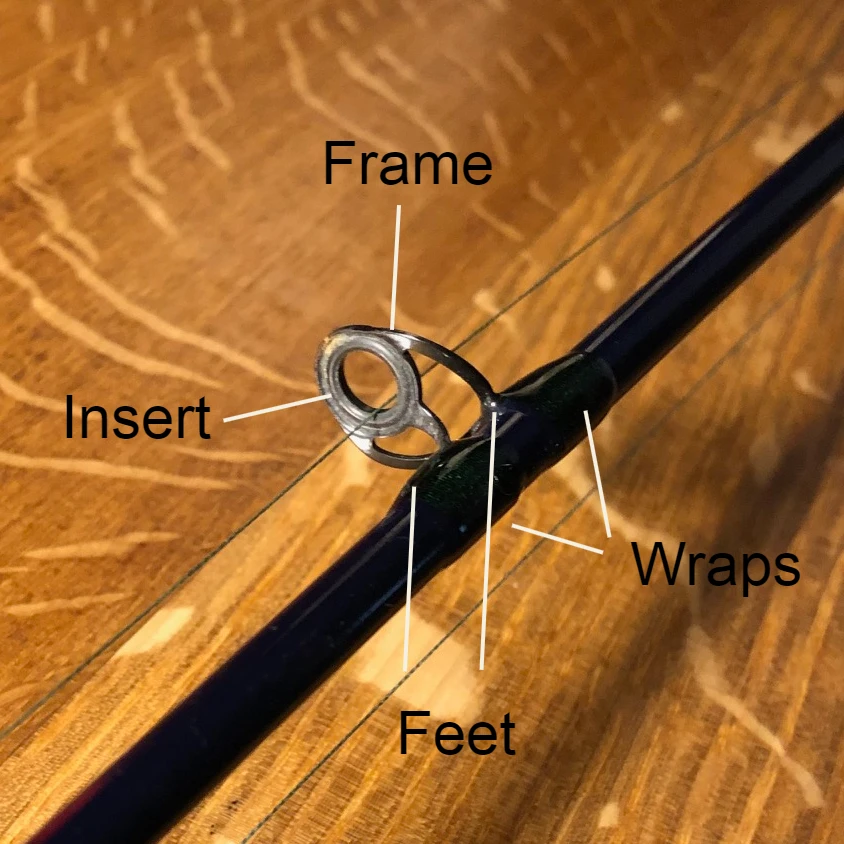
- Guide Frame: The guide frame is the outer structure of the guide, and it holds the other components in place. Guide frames can be made from various materials, including stainless steel, aluminum, or titanium. They come in different shapes and designs, such as single-foot guides (one leg) or double-foot guides (two legs), each serving specific purposes.
- Guide Ring (or Insert): The guide ring, often referred to as the insert, is the central part of the guide through which the fishing line passes. Guide rings can be made from different materials, with common options being ceramic, aluminum oxide, silicon carbide, or other advanced ceramics. The choice of material affects the guide’s durability, line friction, and heat resistance. High-quality materials are used to reduce line wear and heat generation during casting and reeling.
- Guide Wrap: The guide wrap is the thread or thread-like material that secures the guide frame to the rod blank. It is typically coated with epoxy to provide a strong and durable bond. Properly wrapped guides ensure they remain securely attached to the rod during use.
- Guide Foot (Leg): The guide foot is the part of the guide frame that makes direct contact with the rod blank. Single-foot guides have one leg, while double-foot guides have two. The design of the guide foot affects how well the guide distributes pressure and transmits vibrations to the rod blank.
Rod Guide Materials
Rod guides and their inserts come in a variety of materials ranging from stainless steel on the low end to titanium with Silicon Carbide inserts on the high end. Here is an explanation of the advantages and disadvantages of the primary materials used in fishing rod guides.
- Stainless Steel:
- Advantages: Stainless steel is a popular choice for guide frames due to its durability, corrosion resistance, and affordability. It can withstand exposure to saltwater and freshwater environments without rusting or corroding easily. It is also relatively lightweight.
- Disadvantages: Stainless steel may not dissipate heat as effectively as some other materials, which could lead to increased line wear when using heavy drag settings. Stainless steel is relatively corrosion resistant, but not as corrosion resistant as aluminum or titanium.
- Aluminum:
- Advantages: Aluminum guide frames are lightweight and can be anodized for added corrosion resistance. They are often used in high-end guides, especially for fly fishing rods. They provide good strength-to-weight ratios and come in various colors.
- Disadvantages: While aluminum is relatively corrosion-resistant, it is not as durable as stainless steel, making it less suitable for heavy-duty applications.
- Titanium:
- Advantages: Titanium is exceptionally lightweight, durable, and highly corrosion-resistant. It offers the strength of stainless steel with reduced weight, making it a preferred choice for high-end guides. Titanium guides are also known for their excellent heat dissipation properties.
- Disadvantages: Titanium guides tend to be more expensive than stainless steel or aluminum guides, which can increase the cost of the rod.
Guide Insert Materials:
- Ceramic:
- Advantages: Ceramic guide inserts are widely used due to their smooth surface, low friction, and excellent line management properties. They are highly durable and resistant to abrasion, making them suitable for both monofilament and braided lines. Ceramic inserts come in various grades, with higher-quality ceramics providing better performance.
- Disadvantages: While durable, ceramic inserts can be more prone to breakage when subjected to heavy impacts or rough handling.
- Aluminum Oxide:
- Advantages: Aluminum oxide guide inserts offer good performance at a more affordable price point. They are known for their resistance to wear and heat. They are commonly used in mid-range and budget-friendly fishing rods.
- Disadvantages: While suitable for many applications, aluminum oxide inserts may not provide the same level of smoothness and line management as high-quality ceramic or other advanced materials.
- Silicon Carbide (SiC):
- Advantages: SiC guide inserts are exceptionally hard, offering reduced friction and excellent line control. They are highly heat-resistant, making them suitable for use with heavy lines and powerful reels. SiC inserts are often found in premium guides.
- Disadvantages: SiC guides can be more expensive than ceramic or aluminum oxide guides, but their performance benefits can justify the cost for serious anglers.
In summary, the choice of fishing rod guide materials for both the frame and the insert should align with your fishing style, budget, and intended use. Premium materials like titanium frames and SiC inserts offer top-tier performance but come at a higher cost, while stainless steel and aluminum materials provide more affordability and corrosion resistance. The decision ultimately depends on your specific needs and preferences.
Types of Fishing Rod Guides
Fishing rod guides are designed for both the types of rod and the size of target fish. Rod types include spinning, casting, and fly fishing rods. Size of fish can range from small bluegills all the way up to massive offshore game fish like marlin.
Fishing Rod Guide Design Differences
There are three main types of fishing rod guides, each designed for specific fishing techniques and rod styles:
- Spinning Guides:
- Used on spinning rods.
- Typically feature a large ring at the bottom and progressively smaller rings as you move up the rod.
- Usually on the bottom of the rod length.
- Designed for casting lightweight lures and spinning reels.
- Allow the line to flow freely, reducing line twist and improving casting distance.
- Casting Guides:
- Used on baitcasting and conventional casting rods.
- Usually have smaller, more uniform ring sizes along the top of the rod length.
- Designed for pinpoint accuracy and control when casting heavier lures and bait.
- Contribute to better line control and casting precision.
- Fly Rod Guides:
- Specific to fly fishing rods.
- Typically have larger diameter guides to accommodate the thick fly line.
- Guides may be single-foot or double-foot, depending on the rod design.
- Designed to help with controlled casting and line management in fly fishing, where precise presentation is critical.
Single Foot Guides vs Double Foot Guides
Rod guides come as either single-foot or double-foot. This refers to the design of the guide’s frame and the number of legs or feet that contact the fishing rod blank. Each type of guide has its advantages and is suited to different fishing scenarios. Here is an explanation of the differences between single-foot and double-foot fishing rod guides:
Single-Foot Guides:
- Design: Single-foot guides have a single leg or foot that contacts the fishing rod blank. This leg is attached to the guide frame and extends to the rod’s surface.
- Advantages:
- Lightweight: Single-foot guides are lighter than double-foot guides due to having fewer materials. This weight reduction can result in a more balanced and responsive rod, which is beneficial for finesse fishing or when casting for extended periods.
- Less Interference: Because they have only one leg, single-foot guides provide less contact with the rod blank. This can reduce interference with the rod’s natural flex, allowing for better sensitivity and power transmission.
- Flexibility: Single-foot guides are more flexible and can handle the rod’s bending and flexing more naturally. This flexibility can improve casting accuracy and distance.
- Common Usage: Single-foot guides are commonly used on spinning rods and light-action casting rods where lightweight and sensitivity are essential. They are also favored in rod designs that prioritize sensitivity and responsiveness over heavy lifting power.

Double-Foot Guides:
- Design: Double-foot guides have two legs or feet that contact the fishing rod blank. These legs are attached to the guide frame and extend to the rod’s surface on both sides.
- Advantages:
- Strength and Support: Double-foot guides provide more stability and support to the fishing rod blank. This added support is beneficial when dealing with heavier lines, larger fish, or applications that require a stronger backbone in the rod.
- Durability: Double-foot guides are less likely to bend or break when subjected to heavy loads, making them suitable for heavy-duty fishing.
- Line Control: The additional contact points with the rod blank can help maintain better line control, especially when using heavier lines and casting large lures.
- Common Usage: Double-foot guides are often found on baitcasting rods, trolling rods, and heavy-action spinning rods designed for applications like big-game fishing or freshwater trolling. They are preferred when strength and durability are essential.
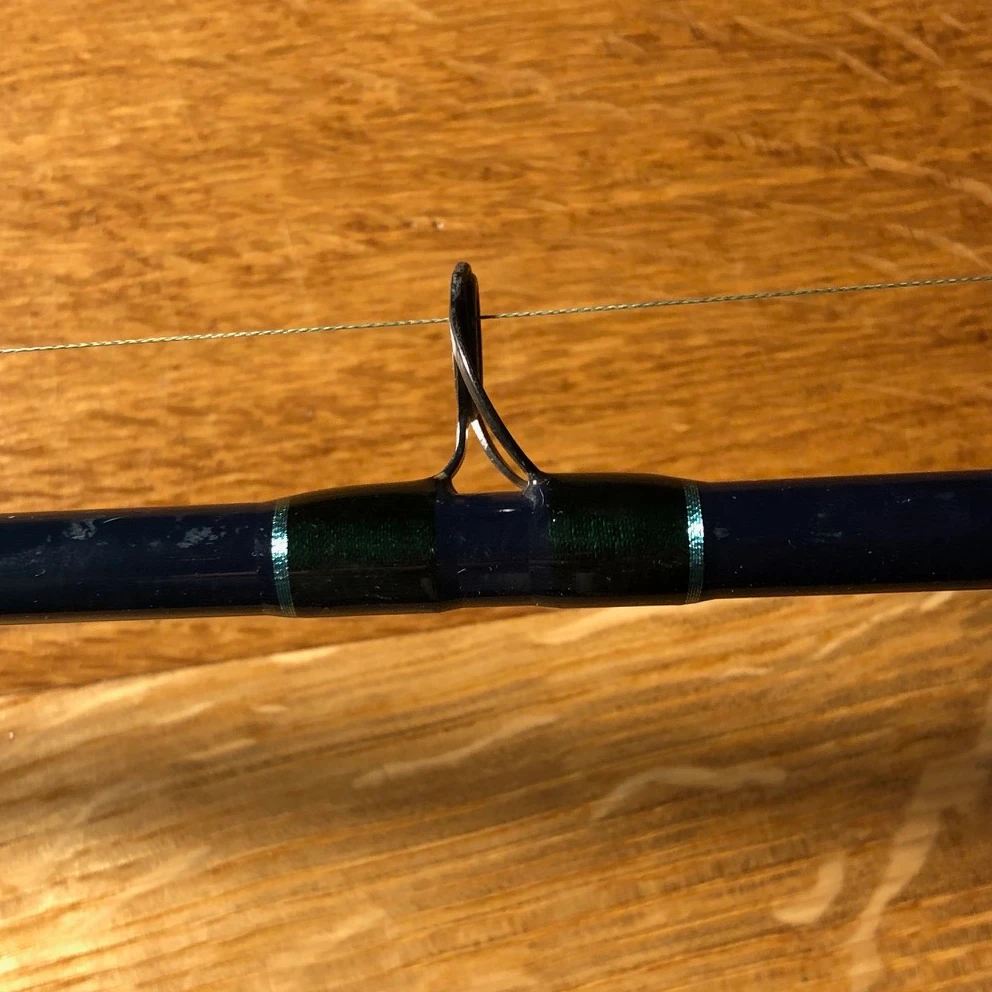
Selecting the right type of guides ensures that your fishing rod is optimized for its intended purpose.
Roller Guides
Fishing rod roller guides, also known as roller guides or roller tip guides, are specialized components designed with small rollers that the fishing line passes over. These rollers reduce friction significantly, allowing the line to move smoothly during casting and retrieval. Roller guides are typically used in heavy-duty fishing applications, such as big-game trolling and offshore deep-sea fishing, where the combination of heavy lines and large fish can generate substantial friction. By minimizing line wear and heat, roller guides help maintain line integrity and prevent damage, making them crucial for handling the extreme forces encountered in saltwater and big-game fishing.
What to Consider When Picking Fishing Rod Guides
Cheap vs Expensive Rod Guides
The key differences between cheap and expensive fishing rod guides mainly revolve around the materials used, construction quality, performance, and durability. Here are some of the primary distinctions:
- Materials:
- Cheap Guides: Inexpensive guides are often made from lower-quality materials, such as lower-grade stainless steel. These materials may be more prone to corrosion and wear over time.
- Expensive Guides: High-end guides are typically constructed from premium materials, which can include advanced ceramics, titanium, or other specialized alloys. These materials offer improved durability and corrosion resistance, contributing to longer guide lifespan.
- Construction Quality:
- Cheap Guides: Less expensive guides may have inconsistent quality control, resulting in imperfections like rough edges or uneven coatings. These imperfections can negatively impact line performance and durability.
- Expensive Guides: Expensive guides are manufactured with greater attention to detail and precision. They are more likely to have smoother, well-finished surfaces and consistent quality, ensuring better overall performance.
- Performance:
- Cheap Guides: Low-quality guides can cause increased friction and line wear during casting and retrieval. This may result in reduced casting distance, accuracy, and sensitivity, especially when using lighter lines and lures.
- Expensive Guides: High-quality guides are designed to minimize friction and line wear, which can lead to smoother, longer, and more accurate casts. They also contribute to better sensitivity, allowing anglers to detect even subtle strikes.
- Durability:
- Cheap Guides: Inexpensive guides are more susceptible to corrosion, especially in saltwater environments. They may also be more prone to bending or breaking when exposed to heavy loads or rough handling.
- Expensive Guides: Premium guides are engineered for long-term durability. They are often more resistant to corrosion and capable of withstanding greater stress and impact, which is particularly important for big-game or heavy-duty fishing.
- Weight:
- Cheap Guides: Lower-cost guides may be bulkier and heavier, potentially leading to a less balanced or less responsive fishing rod.
- Expensive Guides: High-end guides are often designed to be lightweight, contributing to a more balanced and responsive rod. This can be especially critical for finesse fishing or when casting for extended periods.
- Heat Dissipation:
- Cheap Guides: Cheaper guides may not dissipate heat efficiently, potentially causing damage to the fishing line under heavy drag or prolonged fights.
- Expensive Guides: Premium guides are more likely to have heat-dissipating properties, protecting the fishing line from excessive heat during intense battles with large fish.
- Aesthetics:
- Cheap Guides: Inexpensive guides may prioritize functionality over aesthetics, with simpler designs and finishes.
- Expensive Guides: High-end guides often feature more aesthetically pleasing designs, finishes, and custom options, catering to anglers who appreciate both form and function.
How to Pick the Right Fishing Guides for You
When you’re shopping for completely built fishing rods from popular retailers, it’s essential to make informed choices to get the most value for your budget. Here are some tips to help you decipher the fine print and get a rod with rod guides that fit your needs:
- Read the Rod Specifications: All rod manufacturers list what type of rod guides are on their rods. When in doubt, look up the type of rod guides online to determine what materials are used in their construction.
- Consider Saltwater vs Freshwater: Saltwater is highly corrosive and much tougher on lower-end rod guides. If you primarily fish in saltwater, think about purchasing a rod with higher quality rod guides.
- Consider Your Fishing Goals: Think about your fishing style, target species, and intended fishing locations. If you’re primarily a recreational angler, you may not need an ultra-high-end rod. Choose one that aligns with your specific needs.
- Guide Material: Pay attention to the materials used for the rod guides. Guides made from quality ceramics or high-end alloys are typically more durable and provide better value over time.
- Check Warranty and Return Policy: Ensure that the rod you’re considering comes with a warranty or a reliable return policy. This can offer peace of mind in case of defects or issues.
- Inspect Rod Guides: If possible, inspect the rod guides in person at a local store or tackle shop. Check for any signs of damage or misalignment. Ensure that the guides are securely attached to the rod blank.
By following these tips, you can maximize the value of your budget when purchasing pre-built fishing rods. Remember that while guides are an important component, the overall quality and design of the rod should also align with your fishing preferences and goals.
If you don’t want to overthink things, my experience is that the rod guide quality is reflected in the price point of the rod. Luxury rods at high price points will have the best rod guide materials available like titanium and SiC inserts. More budget level rods will have functional rod guides that are still plenty effective, especially if cared for properly.
Rod Guide Care Tips
Taking care of your fishing rod guides is essential to ensure they perform optimally throughout their lifespan. Whether you’re looking to maintain your existing rods, repair damaged guides, or venture into custom rod building, these tips will guide you through the process:
Maintenance Tips:
- Regular Cleaning: After each fishing trip, rinse your rod guides with freshwater to remove salt, sand, and debris. Clean guides prevent line abrasion and maintain casting performance.
- Inspect for Damage: Periodically inspect your guides for signs of wear, nicks, or bent frames. Damaged guides can lead to decreased casting distance and line damage. Replace any damaged guides promptly.
- Check Guide Wraps: Examine the thread wraps on your guides. If you notice loose or frayed wraps, it’s essential to rewrap or repair them to prevent guides from loosening or falling off.
- Lubricate Roller Guides: If you have roller guides, apply a small amount of reel oil or lubricant to the rollers to ensure they spin smoothly. This prevents friction and maintains line integrity.
- Avoid Slamming Rod Tips: Be cautious when setting your rod down or transporting it. Avoid slamming the rod tip or guides against hard surfaces, as this can cause guide damage.
Repairing Rod Guides:
- Replacing Guides: If you have a damaged guide, it’s possible to replace it yourself. Purchase a replacement guide that matches the original size and style, remove the damaged guide, and wrap the new guide in place using guide wrapping thread and epoxy. Allow the epoxy to cure thoroughly.
- Guide Foot Alignment: Ensure that the guide foot (the part that contacts the rod blank) is properly aligned with the rod’s curvature. Misalignment can lead to uneven pressure distribution and affect rod performance.
- Professional Repairs: If you’re unsure about DIY repairs or need more extensive work, consider taking your rod to a professional rod builder or repair service. They have the expertise and tools to perform precise guide replacements and repairs.
Custom Rod Building:
- Selecting Guides: Custom rod building allows you to choose guides that perfectly suit your fishing style and preferences. Consider factors like guide material, size, and spacing. For specific applications, such as surfcasting or fly fishing, research guide types for those scenarios.
- Guide Placement: Pay close attention to guide placement when building a custom rod. Proper spacing ensures even line distribution and enhances casting performance. Manufacturers often provide guide spacing recommendations for their blanks.
- Thread Wraps: Experiment with thread colors and patterns to create a unique and personalized appearance for your custom rod. Ensure that your thread wraps are tight and even to guarantee guide stability.
- Guide Material: Invest in high-quality guides for your custom rod, as they can significantly impact performance. Consider the fishing environment, target species, and line type when choosing guide materials.
- Professional Guidance: If you’re new to custom rod building, seek advice from experienced rod builders or consult resources, such as books, videos, or online forums. Learning from experts can help you avoid common pitfalls and achieve better results.
By following these maintenance, repair, and custom rod building tips, you can extend the life of your fishing rod guides, keep them in optimal condition, and even create a custom rod tailored to your unique angling needs.
Conclusion
In conclusion, a thorough understanding of fishing rod guides and their impact on your fishing experience is essential for serious anglers. Throughout this comprehensive guide, we’ve explored the intricate world of rod guides, including their various types, materials, and their pivotal role in shaping your fishing rod’s behavior.
You should now possess the knowledge needed to make informed choices when selecting the perfect fishing rod for your specific pursuits. Whether you’re chasing trophy fish in saltwater or enjoying a serene day by the lake, the right rod guides can make a significant difference in your overall fishing performance.
Remember to consider factors such as guide materials, design, and your intended fishing style when making your choices. Also, don’t underestimate the importance of proper guide maintenance and repair to ensure your rods continue to perform optimally.
If you liked this article, we recommend our article on how to choose a fishing rod!
For further reading, check out some of our fishing rod recommendation articles that take rod guides into consideration:
- Best Bass Baitcasting Rods
- Best Bass Spinning Rods
- Best Beginner Fishing Rods
- Best Inshore Rods
- Best Saltwater Fishing Rods
- Best Surf Fishing Rods
- Best Trolling Rods
- Best Walleye Rods

Written By: Andrew Juran
Andrew is a seasoned angler with over 25 years of experience fishing across the United States. He has caught hundreds of fish using various techniques and mentored many in the art of fishing. An advocate for sustainable fishing, Andrew is an active member of the Coastal Conservation Association, an organization committed to marine conservation.
For frequent fishing tips, behind-the-scenes looks, and real-time catches, connect with Andrew on Instagram


